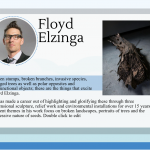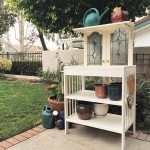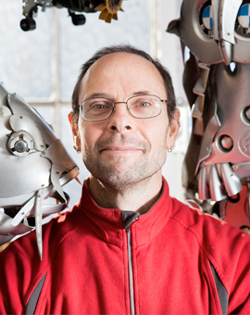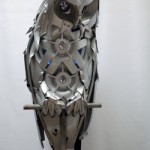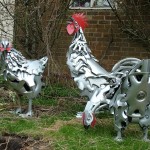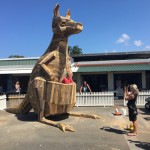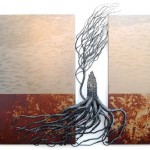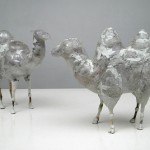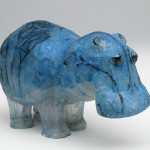Interviewing The Must-follow Upcycling Artists
The reason we started writing this blog post about those creative upcycling artists is actually the previous one, called “What is upcycling“. The aim of our latest blog post was to build more awareness about the topic. Suddenly, during the research about the creative reuse process a.k.a upcycled art, an idea popped up in our minds.
There were tons of information on the internet about how we should learn to create a product of higher quality or value than the original from discarded objects or materials. Furthermore we came across many enthusiasts, who are brilliant at repurposing things and accomplishing amazing upcycled art projects. This motivated us to write this blog post about professional and inspiring upcycling artists and designers. Doing so will help us spread the idea of having a sustainable life, which is as near as possible to the zero-waste concept.
The Upcycling Artists You Should Definitely Know About
- Dinah Wulf
- Ptolemy Elrington
- Thomas Dambo
- Floyd Elzinga
- Shari Mendelson
- Jill
Then we came up with the slogan “we can all make a difference”! And we were all about the idea to make the difference by looking for people, who are actually reducing the need to use more natural resources and spend most of their time upcycling. We wanted to find them and highlight the personalities standing behind the title upcycling artist. So we’ve outreached more than 50 Upcycling craftsman asking them 10 simple questions from which emerged some fantastic ideas for upcycling.
Now the goal is to introduce to our readers and customers, personalities who instead of just talking and advising about how to upcycle, are literally taking the action into their hands as recreating their best upcycling ideas. So, refer to the upcycling artist presented by Rubbish Please: they might seem different at first look, but they all have something in common: they are creative, talented, concerned about the environment and they love to give the trash a new life with their brilliant new ideas for old junk!
Dinah Wulf – The Upcycling Artist Behind DIY Inspired
Dinah Wulf is a work-at-home mom who’s been into creative DIY for the past several years. She’s a globally recognized artist who runs DIY Inspired – Website For Repurposing Ideas and the opportunity to reach her for an interview helped us dig up some sweet information about this guru of the DIY upcycled art.
Dinah gets thrilled when she manages to successfully transform old items into something new. She draws inspiration from her love for flea markets, garage sales and thrift store shopping and proudly admits “there is nothing that can make her stop repurposing“. Dinah creates mostly on her own but when asked if someone helps her she admits: “My husband will help every once in a while.”.
There aren’t any difficulties that Dinah hasn’t managed to overcome. According to her precious experience, “it’s all about trial and error” and if she doesn’t like the final results of any of her projects, she just starts over again until she reaches the desired quality which is a feature of a true professional who loves her job.
Dinah doesn’t spend any time on selling her creations. Instead, she uses them as home decoration or as gifts to someone who shows a significant interest to her work. A lot of her previous work is being kept in her home till now. As you can see, Dinah is a great source of furniture upcycling ideas in addition to the other crafts.
- Steampunk Hat and Goggles
- Upholstered Wooden Bench
- Repurposed Potting Bench
- Wire Fencing for Outdoor Christmas Lights
- An Old Glass Water Bottle
- Recycled Can and Mason Jar Centerpiece
In contrast to our expectations, Mrs Wulf spends very little money on her projects. When we asked her how much she is eager to spend on a project she says: “I spend very little on projects. There is no “maximum” per se, but I don’t believe I have spent very much. I think the most I have spent on a piece of furniture to makeover was $60″. This is definitely a very low amount of cash, considering the quality of her repurposing ideas.
When being asked what she defines as her most successful work, Dinah told us that any furniture she makes is being heavily used by her daughter and their friends which is a strong signal that it makes them happy – we guess this is what is Dinah’s (and many other moms’ ) definition of success. In case you need any ideas for upcycling projects for kids, her website is the right place to explore.
When Dinah Wulf finishes any of her upcycling art projects, she “gets immediately filled with feelings of satisfaction and can’t wait to start the new DIY journey to success“. Her final words of inspiration to our readers are:
“The old saying, “one person’s trash is another one’s treasure”, is very true. Transforming something old and unwanted into something new and useful is a great feeling. As a bonus, you get to keep those treasures out of a landfill.”
Ptolemy Elrington – The Upcycling Designer of The Awesome Hubcap Creatures
Ptolemy Elrington is an artist who collects thousands of lost hub caps from roadsides across Britain and turns them into spectacular animal sculptures.
Working in his own studio, Ptolemy is crafting all kinds of animals using hubcaps from variety of brands including BMW, Mercedes, Ford and Reno and other world popular manufacturers. He fixes the caps together using wire salvaged from scrap yards and cuts them with a craft knife and hacksaw.
Within his work he concentrates on creating sculpture of natural forms from found and upcycled materials. At the moment he is working with a variety of materials including shopping trolleys, scrap metal and car wheel trims which he re-shapes into a variety of life forms. Anything he makes is an astounding upcycled stuff, all of which is unique of its kind.
He says he was inspired by a visit to India in the late nineties. “The poverty-driven creativity I saw there, coupled with a growing awareness of careless waste in this country pushed me in the direction of trying to encourage people to think before throwing away”.
Ptolemy is 100% sure there is nothing that can make him stop doing what he loves. Or maybe he would, if only he was physically unable. Creating amazing upcycling projects is why he gets up in the morning!
There’s always new difficulties in his kind of work, because there are always new challenges. But mostly these come in the form of commissions that tax him and when they tax him it keeps him fresh and excited. “If I’d done it all I would probably not relish my work anywhere near as much”, says the original upcycling artist.
Once Elrington is done with his new project, he puts the hubcap creatures for sale. He would love to keep the art he creates, but this is his full time job so he has to sell it.
Although there are plenty of people out there with advice, Ptolemy runs his business on his own and there is no one who is helping him.
At the beginning of his career he used to use entirely found or donated materials, but as his business has grown and diversified, he was in need to buy some materials.
- Mirror Carp
- A Kingfisher made entirely from shopping Trolley’s
- Horned Owl
- Chickens
- Arctic Wolf
- Scrap Bird
Most notably old shopping trolleys and old car bumpers, because he needs specific colours. His outlay is usually quite small – and the most expensive thing he has bought for work is his welder which was worth a thousand GBP.
As his most successful project Mr. Ptolemy describes the giant bee made for Ecover a couple of years ago. The aim of the sculpture was to promote awareness of a new bottle making process they’d designed that was using waste collected from the oceans. It seemed a very worthwhile project.
He is too busy with running the company and taking care of his family to take on any more work. Thus, he likes to think that his work promotes discussions around the upcycling ethos.
Here’s what he would say to inspire others to upcycle, if he had only 3 sentences to use: “Look around you with honesty and tell me there have been no global weather changes in your lifetime. What sort of world would you like your children to inherit? Together we can effect change but if some of us do nothing we will never succeed.”
When asked about how does repurposing make him feel Elrington says: “I’m getting older and more cynical day by day but repurposing, reusing, recycling and creative thinking about our environment and about solutions to our global problem fills me with hope. That’s why I do it.”
Thomas Dambo – The Upcycling Master of Wooden Sculptures
During his whole life Thomas Dambo has been having an urge to experiment and make stuff. As a kid big tree top houses sparked his interest, as a young teenager – skateboard ramps, later his own bed and stereo rack served as inspiration. In his late teenage years he started doing hip hop music and graffiti painting.
The music took over and he used to spend most of the time promoting it by doing different types of street art or advertising with covers, t-shirts, music videos and screenography for concerts as the music got more popular.
Thomas was rolling solo in this and always made things happen the way he likes it. He is using only tools and materials close to him. He would even “dumpster dive for materials or borrow them, but would never spend money on them”.
Dambo says, “it all taught me that I was able to make pretty much what I wanted without having to pay a lot of money for the materials. It taught that the only limit for realising my imagination was my energy – not the cost!”
Now he is 36 and still works the same way, but more professionally. The upcycling artist has a big workshop filled with different stuff materials he scavenged around the city of Copenhagen such as wood, plastic buckets, t-shirts, action figures or whatever he managed to get his hands on. Thomas gets surprisingly frequently inspired for new upcycling craft ideas which brings a lot of attention on his activity and he also has the talent to see the potential in any items that can be turned into clever upcycled things.
For example, last year Dambo scavenged 500 high quality wheels from a shop refurbishing. But later these wheels inspired him to create an interactive alphabet on wheels. “I didn’t know what to use the wheels for when I first found them, but I saw a potential and got the idea later on.”, says the craftsman.
This is pretty much how the artist works. He is getting his inspiration from the different materials and tools he finds and tries to get the best out of what he’s got.
The pieces of art Dambo is most famous for is the big wood sculptures! “The idea for them came, because I’m always able to scavenge unlimited supplies of wood. So I wanted to come up with an idea that could use all these smaller pieces of wood.”
- Big Boss Bertel
- Frederikke
- Little Tilde
- Rob The Snake
- Kangaroo Kat
- Teddy Friendly
After some experimenting he came up with the idea for the big wooden sculptures and the technique to craft them, that’s why they look so fragmented and all the wood has different colours which adds this specific texture to the final projects which are one of their kind.
When Thomas Dambo is creating a sculpture he likes to let the surroundings inspire him. Dambo’s aim is to make his sculptures live in our world, not to be exhibited on a pedestal. T. Dambo: “The people should interact with them and the environment so the crafts can become more alive”.
Depending on what materials Thomas will be able to scavenge, he defines how the big wooden project will look like. If he scavenges a lot of long boards, it would get long legs, or if he finds a lot of really dark wood, the final project would get a darker body than the usual. This natural final effect is what adds to the desired final texture of the artwork.
He likes to go with the flow. Never plans out everything in details. He says: “If I wanted to plan everything, it would be really hard to build in recycled materials, because it’s hard to guess what I will find.”
His final words of inspiration to all of you should make you reconsider throwing any further waste mindlessly. Thomas Dambo kindly asks you to think twice about the impact of your actions, even when they seem to be not that important at first thought:
“I hope my different art projects will show the world that it’s possible to make anything out of trash “one man’s trash is another man’s treasure” I know it’s a cliche, but I think a lot of people don’t really understand the full meaning of this saying. It goes two ways, and I hope people will think twice before they empty their trash can, because what don’t have value for you, might have a lot of value for others.”
Floyd Elzinga – The Upcycling Artist Who Turns Steel Into Treasure
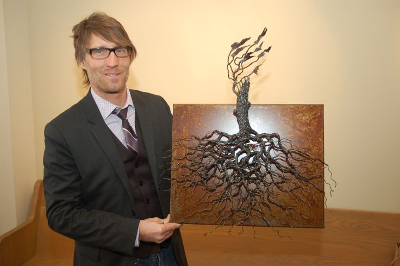
Floyd Elzinga
Floyd Elzinga has over 15 years of experience in three dimensional sculpting and highlight installations. After graduating Fine Arts in the Nova Scotia College of Art & Design in Halifax, Mr. Elzinga became highly interested in working with steel materials because of its “malleable and forgiving nature” and now runs his own website at FloydElzinga.com where he features much of his inspirational upcycled art projects.
We interviewed this true master of upcycling art design to learn more about him in order to share it with you. This unique artist has a great story, he’s been through a lot of hardships and has shared much of his previous and current journeys with us. We couldn’t hold it any longer and decided to show it all to you. Mind that his upcycled art ideas aren’t suitable for anyone as they require a lot of knowledge and experience in working with metals, mostly steel, but this is what makes them even more precious and unique.
What has inspired you to start upcycling/recycling ?
“As the child of Dutch immigrant farmers I was taught from an early age to be conscious of my waste and to be creative with my resources”.
Is there anything that can make you stop upcycling and what is it ?
“The only thing that prevents me from recycling is being in a place (municipality) that has no recycling infrastructure”.
Have there been any difficulties that you still haven’t overcome ?
“The largest difficulty that I have not overcome is getting recycling facilities to allow me to purchase their materials before they are processed. It is disappointing that these government organizations (that are built on the foundation of ‘reduce, reuse, recycle’) are not willing to allow someone like myself to ‘repurpose’ their materials, make money on unprocessed material and save the costly steps of recycling”.
What do you do with the craft once you’re finished ? Do you sell, give or keep as a collection?
“I create sculptures, some of which, are entirely created from repurposed or reclaimed stainless steel that I purchase from a metal salvage yard. These sculptures I sell at art shows, in galleries or online. Previously I would buy new material to make my sculptures and paid a premium for precision crafted stainless steel that was created to engineering standards only to bring it to my studio and smash it with a hammer to create texture…I now dumpster dive and find material that has value added texture already on it!”
- Art
- Broken
- Cones
- Landscape
- Broken Stainless Steel
- Rooted Stainless Steel
Are you upcycling on your own or there’s someone who’s helping you ? Who is he/she and what is the most useful help you get ? Do you wish this person could help you more or less with anything ?
“I have two employees that help me create the sculptures that I make in my studio but the person that helps me with upcycling the most is the owner of the local metal salvage yard. He is very supportive of my artwork and will sometimes save things that he thinks I will like. I wish more facilities like this would consider selling their merchandise to someone like me”.
Do you have anything like a maximum budget for materials or there is no such thing ? What is the highest amount of cash you’ve spent to finish a project ?
“The maximum budget for a project would be in line with the maximum price I could charge for the resulting art work. I have spent several thousand dollars in accumulating used stainless steel pipe and tubing (old pool ladders, milk lines, medical equipment, food processing tools…)that I can use to make trees, branches, and roots”.
What do you define as your most successful upcycling/recycling project ?
“A piece called ‘Broken’ was created entirely out of reclaimed stainless steel. It was an 8′ long replica of a 12” long broken section of a wild grape vine. It was featured in several art exhibitions and won several awards, but the real reward for me was that it was entirely created from repurposed material”.
Have you ever thought about starting a campaign to raise awareness of the upcycling idea ?
“I did have the idea to become the ‘Artist in Residence’ at the local dump. Although on paper my purpose would be to raise awareness about waste management and create positive public relations opportunities, my motives would be to have access to a wealth of ‘other people’s trash’. It could also be used as an educational tool for local schools to come and visit the artist in residence”.
Can you describe how does the repurposing of items make you feel ?
“I am proud to be able to save materials from having to be unnecessarily processed.”
Shari Mendelson – Upcyclling Art Designer Who Turns Discarded Plastics Into Remarkable Sculptures

Shari Mendelson
If there is anyone who can be proud of the many successful exhibitions which are still increasing in number, this is Mrs Shari Mendelson. Mostly being recognized in NYC, Shari has about 30 year of teaching and working experience in sculpture in universities in New York, Brooklyn, Philadelphia, and also served as an online art director for Time Inc.
Currently, she’s inspired mostly by historical ceramic, metal artifacts and discarded plastics. All of her work is definitely distinguished and can be seen at the gallery of Shari Mendelson’s website.
Shari collects numerous bottles of any type and cuts them into pieces to repurpose them in the most creative way possible. Any of her projects is intended to bring associations to history and culture and that can be seen in any of her uniquely upcycled crafts. What is specific about Shari is that she gives brief but very precise information on what materials have been used to create any of the amazing sculptures shown below. Her work brings some great examples of upcycling on the table that cannot be seen anywhere else and definitely deserve to be seen.
What has inspired you to start upcycling/recycling ?
“I had been making art out of sheet plastic that I was purchasing. In my non-art life I recycle everything possible, compost and consider myself an environmentalist. I realized I needed to make my art practice more in keeping with my values. With so much plastic littering the streets of NYC, there was no need to purchase new plastic”.
Is there anything that can make you stop doing it and what is it ?
“I am an artist and there are times when I may want to use other materials for my work. At the present, I’m happy to use recycled materials as the main element of my sculpture”.
Have there been any difficulties that you still haven’t overcome ?
“No real difficulties”.
What do you do with the craft once you’re finished ? Do you sell, give or keep as a collection?
“My main interest is in making the work. My pieces usually get sold through art and design venues”.
Are you upcycling on your own or there’s someone who’s helping you ? Who is he/she and what is the most useful help you get ? Do you wish this person could help you more or less with anything ?
“I have friends and family that collect plastic bottles for me. I could not find enough material without their help. I am so grateful whenever someone gives me a plastic bottle and says, “I saved this for you.” It takes a village”!
- Upcycled Camels
- Upcycled Glass Animal
- Upcycled Green Vessel
- Upcycled Hedghow Bootle
- Upcycled Hippo
- Upcycled Vessel Pink and Silver
Do you have anything like a maximum budget for materials or there is no such thing ? What is the highest amount of cash you’ve spent to finish a project ?
“I start with the found plastic bottles. I use a variety of acrylic polymers and glues for putting the pieces together and giving them the final surface treatment. I don’t think in terms of budget. My work doesn’t cost much in terms of material but it is labor intensive and time is a valuable commodity”.
What do you define as your most successful upcycling/recycling project ?
“I’m usually most excited about the next piece I’m going to make”.
Have you ever thought about starting a campaign to raise awareness of the upcycling idea ?
“No. Hopefully, I can be an example but collecting trash and repurposing it isn’t for everyone. I would like to encourage people to use less, to think about their purchases, and to pay attention to and boycott buying products that use excessive packaging”.
If you had only three sentences to inspire a group of people to start recycling, what would they be ?
“Where is all that trash going to go? Think about the fish in the oceans! Think about the future generations”!
Can you describe how does the repurposing of items make you feel ?
“Always feels great when I make a piece I like, knowing that it’s made from the trash that was littering the streets”.
Jill – The Australian Artist Who Has More Than 600 Clothes Upcycling Ideas For You
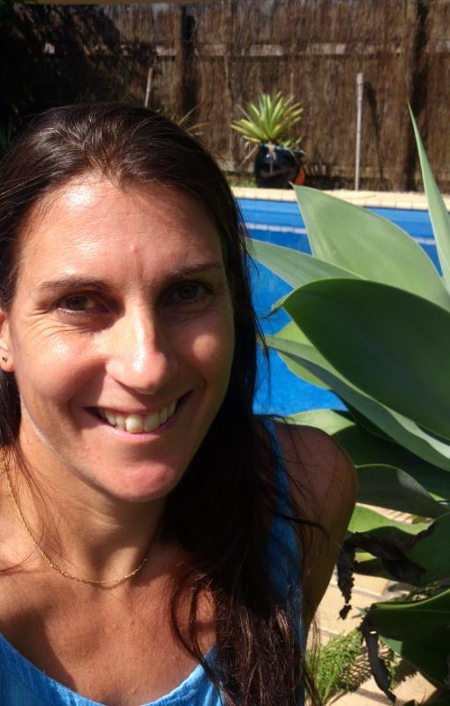
Jill is currently creating her way to success and hates to throw anything out. She was lucky enough to learn to sew as a child and she describes her mother and grandmother as the perfect teachers. Jill managed to develop her sewing skills and implement them into the upcycling process.
“I use old clothes, fabric remnants and anything else that I can put through my sewing machine to create things my family and friends need, want and can use. Creativity is the key to using what you’ve got.”
Here is what we asked one of the best sewing upcycle artist!
What has inspired you to start upcycling/recycling ?
“Growing up my with my parents always made use of everything they had and that included lots of upcycling and recycling. I guess I’ve just kept that thrifty attitude and can’t stand to see anything wasted. I learned to sew from my mum and granny and once I had kids of my own I got back to sewing to make things for them. I like to use the materials and resources I have on hand – and I started out sewing with old clothes and bedding so things I made cost me virtually nothing but my time”.
Is there anything that can make you stop doing it and what is it ?
“I’ve been asked if I would still upcycle and recycle if I had lots of money, and the answer is yes. Over the years I haven’t been able to justify spending lots of money on fabric to sew with, as you can buy finished things so cheaply now so it’s no longer always cheaper to make your own things. However, I strongly believe we should use the resources we already have in the world rather than constantly producing new ones. I love the challenge of upcycling something that someone else has discarded into another thing that somebody else will use and love. So no, I don’t think there is anything that would make me stop upcycling”!
Have there been any difficulties that you still haven’t overcome ?
“The only difficulties I have found with upcycling is finding a few materials to complete some projects. There are still occasional, odd moments I do buy new stuff to complete for example a bag I’m making. But I’m always looking out for alternatives to any store bought materials I use! I don’t have a maximum budget as such for my upcycling projects, I just try to spend nothing if possible”!
What do you do with the craft once you’re finished ?
“Generally I make things that our family needs or will use – for example toys for my kids, bags, and things to use in the kitchen like oven gloves and reusable snack bags. I also make gifts for family members and my daughters’ friends when it is their birthdays and Christmas”.
Are you upcycling on your own or there’s someone who’s helping you ? Who is he/she and what is the most useful help you get ? Do you wish this person could help you more or less with anything ?
“The help I get while upcycling comes from friends bringing me their old clothes and things to sew with rather than throw them away! I often get handed a bag of things with the words, “I thought you could make something with these”! I’ve started to turn this around and use the things they give me to make gifts for them that they can then use themselves. I’ve started doing this to stop my house being overwhelmed with other people’s old clothes etc”!
- Shopping bag
- Shopping Bag
- Michelle’s bag
- Niki’s bag
- Judith’s bag
- Alison’s bag
Do you have anything like a maximum budget for materials or there is no such thing ? What is the highest amount of cash you’ve spent to finish a project ?
“No, I don’t have a maximum budget for materials! As I said most of the products I use are brought to me by my friends so I don’t really need to spend cash on my upcycling projects”.
What do you define as your most successful upcycling/recycling project ?
“My most successful upcycling project is definitely my Eco-friendly shopping bags. This is a bag that took several years to design and create exactly as I wanted it for my needs. I use mine every week now when I do my grocery shopping! Basically it’s a stylish handbag, made from old denim jeans and fabric scraps, that has a hidden pocket in the bottom where there is a bag of reusable shopping bags stored (made from old sheets).
I wanted a way to never forget my reusable bags when I went shopping, and this was the solution. There are also reusable fruit and vegetable produce bags in the side pockets, made from old net curtains, and an additional handibag in the handbag, made from an old pillowcase, in case you buy extra things! I created tutorials for making all of these bags and put them in an e-book which I sell for the price of a cup of coffee and donate money to the WWF from sales. I wanted to encourage others to upcycle too and help reduce the need for plastic bags. I don’t really make any money from this book, the income just covers the selling costs and the remainder goes to the WWF. I guess this is kind of my own little ‘campaign’ to raise awareness of upcycling”.
Have you ever thought about starting a campaign to raise awareness of the upcycling idea ?
“I try to raise upcycling awareness through my blog and social media platforms. As my blog grows so does hopefully my reach of people that I can spread the word to and encourage to use the resources we have on hand rather than always look to buy new”.
If you had only three sentences to inspire a group of people to start recycling, what would they be ?
“Use what you’ve got. The answer is to not always spend money. You can do or create anything you set your mind to” .
Can you describe how does the repurposing of items make you feel ?
“Repurposing materials makes me feel good about what I’m doing. I feel like I’m setting a good example for my kids and treating our world with the respect it needs and deserves. If I can make a small difference and inspire even one person to reuse things rather than throw them away, then I feel like what I’m doing is worthwhile. Of course I would love to make a big difference and inspire hundreds, thousands and even millions of people to upcycle, and use what they’ve got. So I’ll continue upcycling and sharing my work with whoever shows an interest” !




